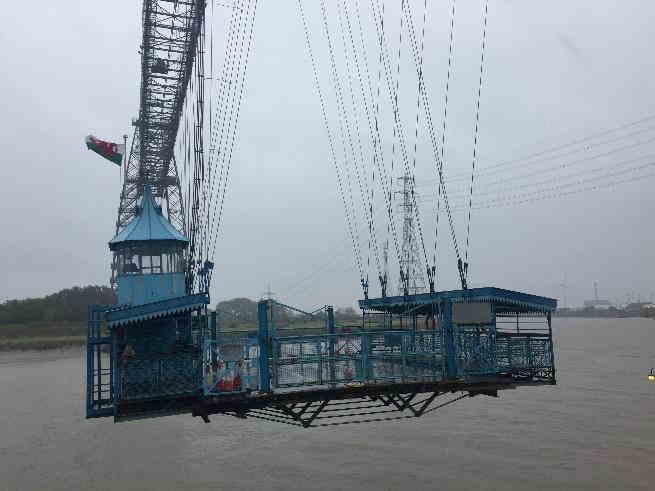

Number 584 November 2019 Edited by Micky Watkins
HADAS DIARY – LECTURE AND EVENTS PROGRAMME 2019
Lectures start at 7.45 for 8.00pm (unless otherwise stated) in the Drawing Room, Avenue House, 17 East End Road, Finchley N3 3QE. Buses 82, 143, 326 & 460 pass close by, & it is five to ten minutes’ walk from Finchley Central Stn (Northern Line). Tea/coffee & biscuits follow the talk.
Tuesday 12th November 2019: Shene and Syon: a royal and monastic landscape revealed by Bob Cowie.
Bob spent most of his career working as a field archaeologist with MOLA (1983–2017), notably on sites in Lundenwic, spending evenings teaching extramural students at Birkbeck about the archaeology of Saxon and medieval England. He began digging and finds processing with the
Wandsworth Historical Society in 1974, and later became longstanding member of the Richmond Archaeological Society, who helped investigate some of the sites that will be reviewed in his talk. His lecture concerns three riverside sites, which together form a nationally important historic
landscape. The earliest of these was Shene Palace, which Henry V began to rebuild with the intention of making it his dynastic seat. He also intended to found three religious houses nearby. One was to be a French Celestine monastery, but this scheme was abandoned following the outbreak of war with France. The other two monasteries comprised a Carthusian priory (Shene Charterhouse) and a Bridgettine abbey (Syon), which in their day represented a late, albeit isolated, flowering of medieval monasticism. Forty years after their final closure, when little survived of these two great religious houses, they were immortalised by Shakespeare as ‘two chantries where sad and solemn priests still sing’ (Henry V, Act 4, Scene 1). Most of the royal palace was swept away during the Commonwealth.
Sunday 1st December 2019 Christmas Party at Avenue House, 12.30pm – 4pm. The application form with the menu which will be a Christmas lunch, with alternatives is with this newsletter. £30 per head.
Tuesday 14th January 2020 at 2.30pm Ian Jones. Shelters to Shrapnel, surviving traces of Enfield at War, 1939-1945
Tuesday 11th February 2020. The Dorothy Newbury Memorial Lecture
Jon Cotton Prehistory in London – some Problems, Progress and Potential
EAST BARNET PARISH CHURCH – ST MARY THE VIRGIN Deirdre Barrie
If you are walking across Oakhill Park, East Barnet, your eye may catch sight of a mysterious large expanse of white at the top of the hill. As you draw nearer, the white becomes an ancient wall with three little windows in it. This is the north wall of the Church of St Mary the Virgin, which dates
back to 1080. It was then that the Benedictine monks of St Albans Abbey founded a small chapel.
Those Norman windows in the wall would not have been glazed, and the pieces of glass there now are remnants of the church’s medieval glass.
At the entry, you’ll notice a stile beside the lych-gate. This was once to allow access when the graveyard gates used to be closed to prevent animals straying in. The tiny, peaceful churchyard itself is kept as a conservation area for flora and fauna, and a little tour of it is well worthwhile. A thought-provoking blue leaflet available inside, “A Prayer Walk around the Churchyard” is full of interesting details of the graves. The very tall monument near the road is to Simon Houghton Clarke (9th Baronet), and is placed there so that his widow could see it from Oak Hill, a large white house still visible a few miles away and which is now a religious college.
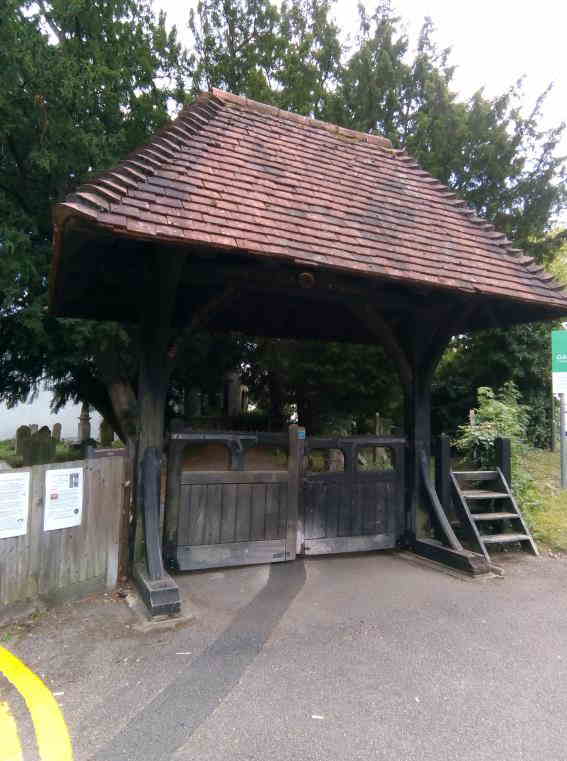
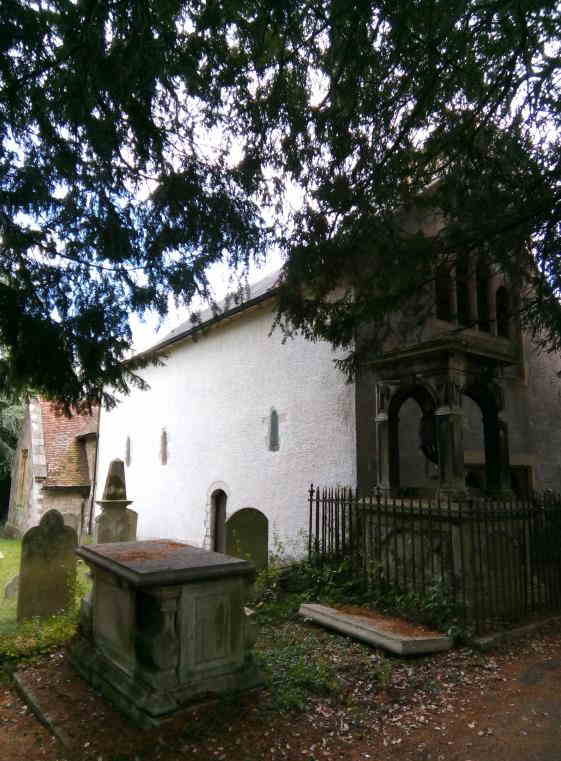
The first chapel on the site had thick walls built of compressed rubble, lime and plaster, with stone round just the windows, while the frame of the door on the south side is probably from the Norman or Saxon period. There have been many alterations and enlargements to the church since. The chancel was built about 1400, while the first gallery was probably built in the reign of King James I, and used as a school room. In 1805 the church walls were raised by four feet, and a little later, in 1828, the tower was built, in neo-Norman style. Its three bells were recast in 1961 from the two original bells cast at the Whitechapel Bell Foundry in 1861. (Alas, the Foundry closed in 2017). The tower is only 50 feet high, but tower and flag are visible from a good distance.
An amusing story is told in “The Little Church on the Hill”, a leaflet produced to celebrate the 925th Anniversary of the consecration of the church:
“In 1423 the Archbishop of Canterbury passed through Barnet, and the rector and priest were reprimanded for not ringing the church bells in his honour. When the offence was repeated the following year, the Archbishop ordered the church doors to be sealed as a punishment.”
The dissolution of the monasteries meant that King Henry VIII took over the ownership of the Manor of Chipping and East Barnet, and his son Edward VI sold on the Manor of East Barnet in 1553, but kept the patronage for himself. This means that even today the Sovereign is the patron of this church.
The church organ is apparently a very fine instrument for so small a church, and was installed in 1920 in memory of the Vernon Family’s only son, who was killed in WWI.
The nave of the church stands on the site of the original chapel, well over 925 years later, and St Mary’s is still very much alive as a centre for the community. The church is open to visitors from 10am-2pm on Saturdays. For more information see their website: http://www.stmarys-eastbarnet.org.uk/?page_id=50
THE LONG TRIP OF 2019 Jim Nelhams
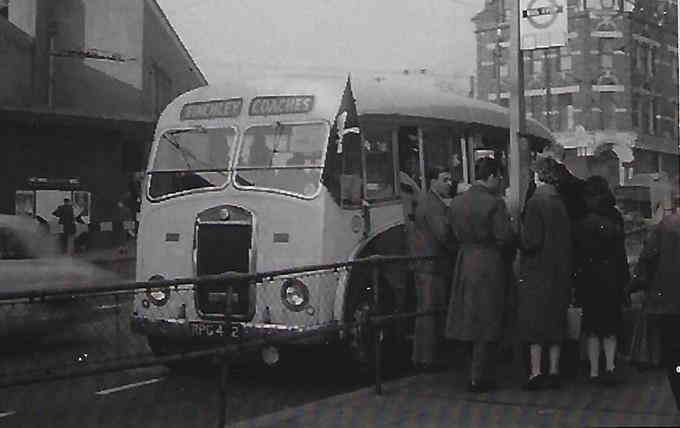
After a tour of pick-up points, 36 members and friends headed westward for our four-night stay in Aberavon on the east side of Swansea Bay. A comfort break at Beaconsfield and on to Newport for our first two visits, but not in the coach shown above – an updated version.
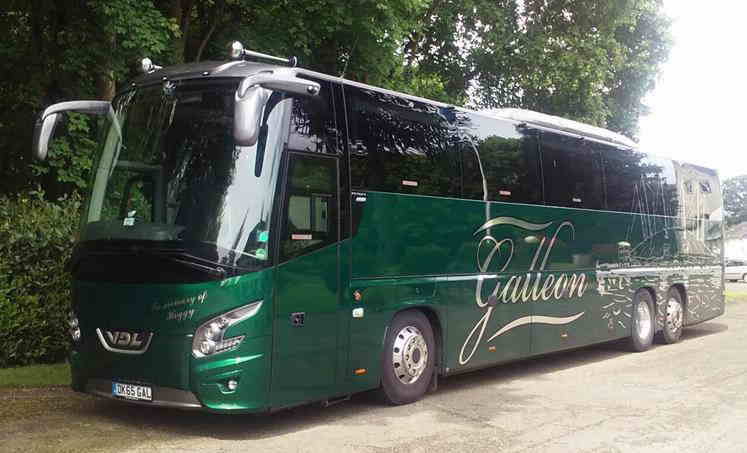
Our first stop was to be the Newport Medieval Ship, recommended by Peter Pickering, though the Friends of the Ship had a marquee next to Hadas at this year’s Barnet Medieval Festival. At Newport, we were joined by a further five people. How nice it is that members who have moved out of the Barnet area still want to come and join us for our trips.
The Newport Medieval Ship
Newport sits on the River Usk, which is tidal and drains into the Severn Estuary. The Romans came to the area, with their camp at Caerleon, on the north side of Newport. Later, the Normans built Newport Castle. The main trading port in the area was Bristol, but Newport was a good site for ship repairs. In the summer of 2002, a new Arts Centre was being built on the riverbank in the centre of Newport. While excavating the orchestral pit, the remains of a fifteenth century boat were discovered, though concrete piles had already been drilled through the hull. Disassembling the remaining timbers tool over 3 months. Toby Jones, the curator of the Newport Medieval Ship project told us what had happened since, and what history of the boat had been established.
The ship was clinker built mainly of oak with a keel of beech. The length of the boat is about 100 feet, just small enough to fit in the warehouse where reconstruction is under way. Most of the timbers had been dated to just after 1450 and from the Basque country of Northern Spain. It is likely that the ship had been involved in the Iberian wine trade. She had been much repaired, and it would appear that during repairs around 1468, she fell on her side. Much of the upper structure, masts etc, had been salvaged for re-use, leaving a large section of the hull, which became subsumed into the mud.
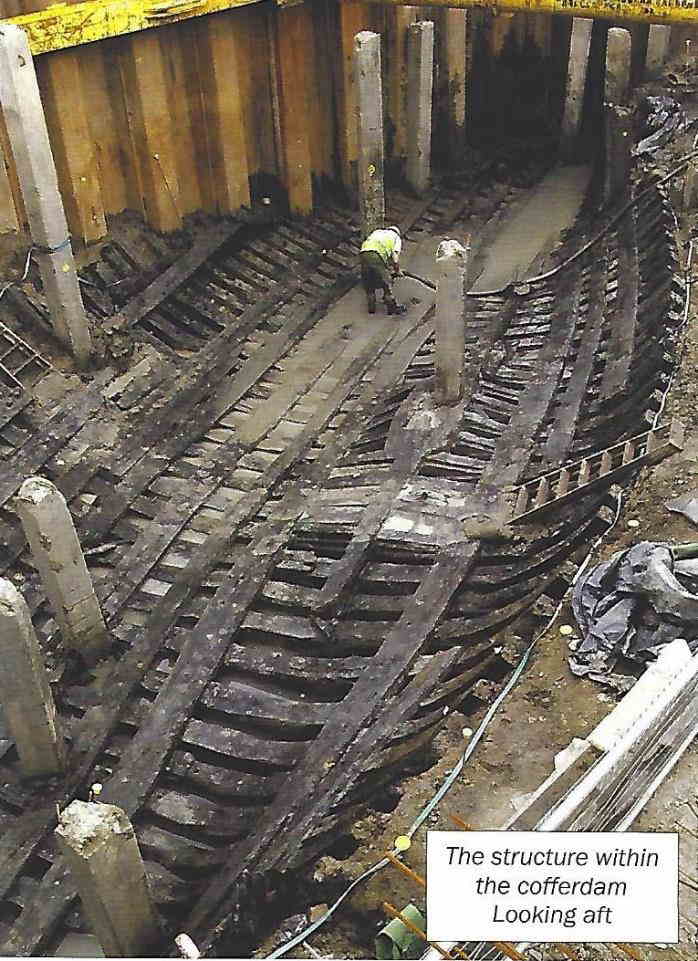
About 1,000 artefacts were recovered, including coins, 500+ pieces of ceramic, shoes, textiles, combs, stone shot, but no guns and three pumps. The silt around the hull was bagged and awaits future inspection and is bound to add to the information. The timber pieces have been scanned in three dimensions with the results used to produce one tenth scale copies on a three-dimension printer. These have been assembled to provide a model and template for further reconstruction.
The Newport Transporter Bridge
In 1896, John Lysaght of Wolverhampton wanted to build a steel works on the East Bank of the Usk, but most of the potential workforce lived on the opposite bank, and the Town bridge was becoming congested. A ferry was out of the question because of the tides and the muddy banks. The solution had to allow the passage of shipping at high tide. Tunnels and a high-level bridge were considered but were too costly. Robert Haynes, the Borough Engineer became aware of the work of
French engineer Ferdinand Arnodin, whose idea of an “aerial ferry” seemed to solve the problem within the available budget. This type of construction, now generally called a transporter bridge, consists of braced towers on each bank supporting a cross girder. From this is suspended a cradle or gondola on wires, which can be moved back and forward across the river.
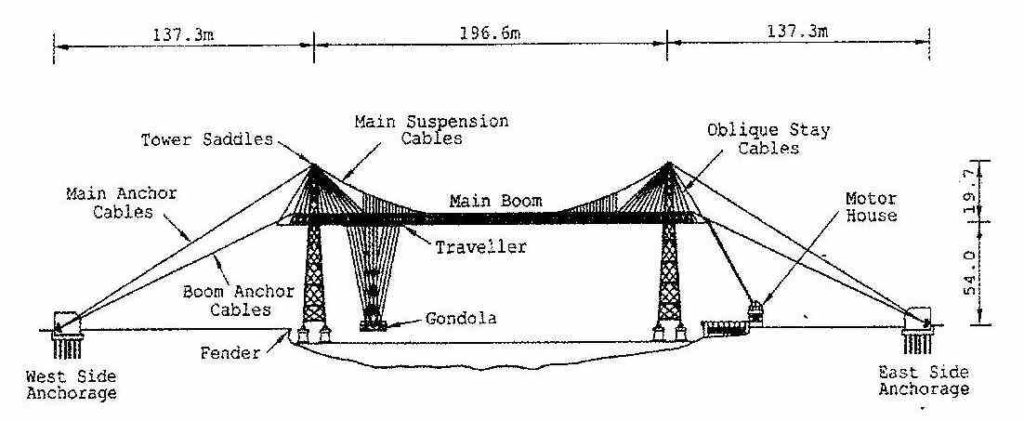
(Plan of the Newport Transporter Bridge)
Eighteen transporter bridges have been built worldwide, with 6 still operating. Of the four erected in UK, Newport and Middlesbrough, across the Tees, are still operating.
Sadly, the inclement weather discouraged some from leaving the coach, and everybody declined the option of climbing the stairs at the side to walk across the top and down again.

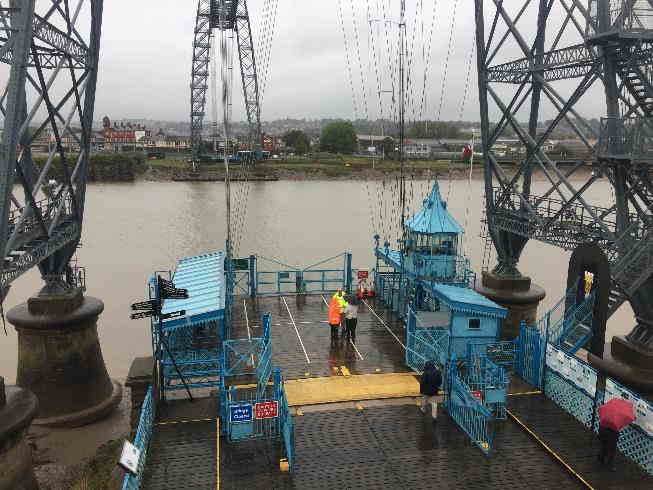
(Photos – Andy Simpson)
As well as foot passengers, the gondola has space for 6 cars to cross at ten feet per second. Our passengers crossed over and were able to visit the motor control room which incorporates the winding machinery. This was operated by one of the knowledgeable volunteers.
Welsh Road Signs
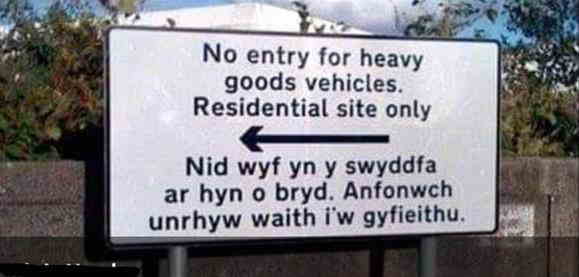
Having crossed the New Severn Bridge (tolls were discontinued last year), we started to notice the road signs. In Wales, it is a legal requirement that road signs be in both English and Welsh but not all the people involved with road maintenance are Welsh speakers.
In this case, an official of the Highways Department emailed the English wording for a sign to a translator and, after receiving a reply in Welsh, proceeded to have the sign made up and installed. A few weeks later, Welsh-speaking drivers began to call up to point out that the Welsh read … “I am currently out of the office. Please submit any work to the translation team.”
TED SAMMES CLAY PIPE COLLECTION – PART 3 Andy Simpson
This concludes the serialised article – see Parts 1 and 2 in the August and September 2019 HADAS Newsletters (newsletters 581 and 582)
MILL HILL AREA
Hammers Lane NW7
Many readers will be familiar with the steep climb up Hammers Lane (B1461) from Daws Lane up to The Ridgeway, if only to get to The Three Hammers Pub at the top! There has been an inn on this site since around 1680, the current building dating to 1938. Hammers Lane was for a while known as Ratcliffe Lane. Somewhere along here were found several pipes, recorded in 2019 as a combination of Sammes master list nos. 151 and 152.
There is a curiously ‘bent’ length of stem, with ‘Diamond Nipple’ end, – possibly part of a novelty coiled pipe of around 1780-1820 plus three bowls; two part bowls with spurs and length of stem of type AO27, dated 1780 – 1820, both with ‘RMSS’ makers marks, one ‘CD’ and the other ‘GC’
Also found at Church Terrace, Hendon, CD may represent pipe maker Charles Dickens, Hornsey 1788 or Charles Dickens, Spitalfields 1817-28.
The other bowl is post 1840 from ‘The Laurels’, Hammers Lane, with a neatly cut bowl top. It was presumably recovered along with the Victorian small glass R Whites Syrups bottle also in the HADAS archive and marked ‘Laurels Hammers Lane 1974’
Local resident Neil Weston kindly confirms that The Laurels is a property right at the top of Hammers Lane, almost opposite the Three Hammers. It is still residential and has the appearance of an old-style cottage, a slight throwback to an earlier era.
The HADAS archive also includes 18 short, unmarked clay pipe stem fragments recovered when Bill Bass and the late Brian Wrigley of HADAS were site watching the holes dug for tree planting in Mill Hill Park, south of Daws Lane (NGR TQ2190 9210), on 5-6 December 1994. Brian Wrigley noted that the field boundaries reflected those shown on maps back to 1754 (Crow), with the former Daws farm north of the site – like most farms in the area it would have concentrated on hay production to feed the horses of eighteenth and nineteenth century London, Mill Hill being noted for its good quality hay.
Not too far away, at Galen House, Burton Hole Lane, NW7, leading off the ancient Ridgeway and adjacent to the recently sadly demolished 1939-built landmark, the former National Institute for Medical Research, were found two complete bowls of type AO25, dated 1700 – 1770. Both with neatly cut bowl tops, both maker’s marks are the familiar ‘RMSS’ one , Sammes no. 148 with a partly illegible maker’s mark(?) T ? found/owned by a H W Spooner and the other, Sammes 149, with a good length of stem and maker’s mark ‘TH’ – possibly Thomas Hodges, recorded at Smithfield, 1800, as also found at Burroughs Gardens in 1972.
CHILD’S HILL NW2
With a small hamlet already established by the time of John Roque’s map in 1756, the area was then well known for brick and tile making until the kilns were demolished for the building of the Finchley Road in 1828.
Two fairly early pipe bowls were found in Granville Road, which runs off The Vale adjacent to Childs Hill Park, south of the centre of Golders Green. Both unmarked bowls, Sammes List CFM 11 and CFM 12, are of type AO12, dated 1640-1670. Both have full milling decoration around the tops of the bowl
TEMPLE FORTUNE AREA
This general area is VERY well represented in the Sammes Collection, possibly because of the number of HADAS members who lived in the area at the time. Previously a hamlet amongst farmland, the area gradually developed following the opening of the Finchley Road turnpike and associated coaching inns from 1830, but was still semi-rural as late as 1906 but rapidly developed after the arrival of the ‘tube’ at Golders Green in June 1907.
2, Willifield Way, off Finchley Road – one part bowl and part stem, type AO25, 1700- 1770, unusually with an ‘X’ visible at the bottom of the bowl, and with a cut bowl top.
66, Hampstead Way NW11 – one bowl of form AO31, 1850 – 1910, Sammes No 97. Stem fragment with heel and part of bowl. Stamped shield mark on side of heel.
Hill Close, NW11 (off Hampstead Way) Two bowls, one part bowl of type AO26, 1740-1780, with coat of arms, maker’s mark on spur possibly IP, Sammes No 147.(I was commonly used for J in this period)
The other full bowl of type AO29, 1840-1880, makers mark on spur WB, Sammes No 146.
9, Asmuns Place, also off Hampstead Way – one complete bowl, type
61 Erskine Hill, off Addison Way, NW11. Two bowls – one type AO9, 1610-1640, with full bowl milling. Sammes List 113.The other type AO10, 1640-1660, Sammes List 114, again with full bowl milling.
56 Temple Fortune Lane (off Finchley Road) NW11
Part of bowl only, type AO27, 1780-1820. Mark on side of spur ‘CD’ Again may represent pipe makers Charles Dawkins, Hornsey 1788 or Charles Dickens, Spitalfields 1817-28.
? Giten Close NW11
The original record/label was hard to read and the A to Z shows no road/close with this name, other than one in Bromley!
What is clear is that it is a bowl, with damaged top, of type AO10, 1640-1660, with very partial milling and a cut top. No Sammes Number.
6 Temple Fortune Hill NW11 (Leading to ‘Big Wood’)
A particularly large collection of pipe fragments and other related material.
Complete bowl type AO4, 1610-1640. Full milling. Sammes No 64.
Complete bowl type AO9, 1640-1660. Full milling. Sammes no 66.
Damaged bowl type AO10, 1640-1660. No milling. Sammes No 65.
Complete bowl type AO11, 1640-1670, with incised line at rear. No milling. Sammes No 70.
Complete bowl and part stem, type AO12, 1640-1670. Full milling. Sammes No 71.
Complete bowl type AO15, 1660-1680. Half milling. Sammes No 67.
Complete bowl, Type AO15, 1660 – 1680. No milling. Incised line on part of rim. Sammes No 68.
Complete bowl and part of stem type AO15, 1660-1680. Half milling. Sammes No 69.
Bowl only, type AO15 1660-1680.Half Milling.
Bowl and half stem, type AO15, 1660-1680. Three-quarter milling.
Half bowl, missing spur, type AO22? 1680-1710
One bowl with moulded rabbit design either side. Ribbed wheatsheaf seams on bowl. Sammes No 85.
Bowl type A033, post 1840, with basket design. Sammes No 86
Bowl type AO33, post 1840, Thorn design, with most of stem. Sammes No 87.
Plus 15 stem fragments approx. 5-7mm diameter, and 30 8-10mm diameter.
Plus corroded and totally illegible coin, possibly a farthing.
Well- worn 1917 penny.
Rolled copper strip with central channel.
Circular Bakelite fitting
Tinned iron 3d token – T. Salmon & Son Ltd (from Grocery/Household store in Holloway N1 and other branches)
WHETSTONE
The Sammes Collection includes one rather lonely pipe from Whetstone, a bowl of type AO15, dated 1660-1680 from 9, Elmstead Close, Whetstone N20, close to Totteridge Village cricket ground. Sammes No 76, it has full milling and a neatly cut bowl top.
Exhibitions:
British Museum. Troy: myth and reality. Opens 21 November 2019 – 8 March 2020. Adults from £20.00. BM Society Members and children Free
Imperial War Museum. What Remains In partnership with Historic England this exhibition explores why cultural heritage is attacked during war and the ways we save, protect and restore what is targeted. Over 50 photographs, oral histories, objects and artworks will be on display Information from IWM website.
Saatchi Gallery, London. Tuankhamun : Treasures of the Golden Pharoah 150 original artefacts. 2 Nov. 2019 – 3 May 2020
OTHER SOCIETIES’ EVENTS Compiled by Eric Morgan
BARNET LIBRARIES 90 years collecting: Barnet Local Studies Exhibition
04 NOV. – 24 NOV: EDGWARE LIBRARY, Hale Lane HA8 8NN
04 NOV. – 30 JAN: HENDON LIBRARY, The Burroughs NW4 4BQ
05 NOV. – 19 NOV: CHIPPING BARNET LIBRARY, Stapylton Rd EN5 4QT
19 NOV. – 03 DEC: NORTH FINCHLEY LIBRARY, Ravensdale Ave N12 9HP
25 NOV. – 18 DEC: BURNT OAK LIBRARY, Watling Ave HA8 0UB
04 DEC. – 18 DEC: EAST FINCHLEY LIBRARY, 226 High Rd. N2 9BB
18 DEC. – 08 JAN: FINCHLEY CHURCH END, 318 Regents Park Rd N3 2LN
20 DEC. – 02 JAN: COLINDALE LIBRARY, Bristol Ave NW9 4BR
02 JAN. – 23 JAN: GOLDERS GREEN LIBRARY, Golders Gr. Rd NW11 8HE
08 JAN – 23 JAN: OSIDGE LIBRARY, Brunswick Park Rd N11 1EY
Wednesday 13 Nov. 7.45pm 7.30pm for 8pm Hornsey Historical Society. Union Church Hall, Ferme Park Rd. N8 9PX. Professor Ian Christie: The World’s First Film Studios? Putting R. W. Paul Back on the Map for his 150th Birthday: Visitors £2. Venue omitted from previous newsletter
Thursday 14 Nov. 6pm. Gresham College, Barnard’s Inn Hall, Holborn EC1N 2HH Sir Thomas Gresham and the Tudor Court. Talk by Prof. Alexandra Gajda. Free
Tuesday 19 Nov. 7.30 pm. Barnet Museum and Local History Society, AGM Barnet Church EN5 4BW
Thursday 20 Nov. 7.30pm Finchley Society, Avenue House, East End Rd N3 3QE Finchley Origins – from a Common to a Conurbation Talk by Hugh Petrie, Barnet Archivist (Jean Scott Memorial Lecture).
Saturday 23 Nov. 10.30 am. Willesden Local History Society, Kilburn Lane W10 4AA. Guided tour round the church with Fr. David Ackerman
Tuesday 26 Nov – 19 April. Enfield at War 1939-45. Exhibition at Museum of Enfield, Dugdale Centre, 39 London Road, EN2 6DS –
Tuesday 26 Nov. 1-1.45 pm. The archaeology of War Talk by Ian Jones
Wednesday 4 Dec. 7.00- 9.00 pm Secret Wartime Britain. Talk by Colin Philpott
Tuesday 10 Dec. 1-1.45pm Heroes and Victims. Talk by Ian Jones on air raids on Enfield
The talks at Dugdale Centre are free but reservations is advised on www.dugdalecentre.co.uk or phone 020 8807 668010 –
Wednesday 27 Nov. 7.45pm Friern Barnet and District Local History Society, The Manor House, Friern Barnet Lane, N20 0NL The London Cage – Britain’s secret interrogation centre in WW2. Talk by Helen Fry.
Saturday 7 Dec. 10.30 am-2.30pm Hornsey Historical Society, Old School House, 136 Tottenham Lane N8 7EL. Local History Surgery with John Hinshel Wood. NB. The 13 Nov talk will be at Union Church Hall, Ferme Park Rd. N8 9PX
Tuesday 10 Dec. 6.30 pm LAMAS, Clore Learning Centre, Museum of London, London Wall EC2Y 5HN. Denmark Street revealed. Talk by Robert Hradsky on how a remarkable group of 17th century houses were adapted to support a specialist enclave of metal workers in the 19th century and a thriving group of music publishers in the 20th century. Refreshments 6pm
With thanks to this month’s contributors:
Deirdre Barrie, Jim Nelhams, Andy Simpson and Eric Morgan
Hendon and District Archaeological Society
Chairman: Don Cooper, 59 Potters Road, Barnet, Herts. EN5 5HS (020 8440 4350) e-mail: chairman@hadas.org.uk
Hon. Secretary: Jo Nelhams, 61 Potters Road Barnet EN5 5HS (020 8449 7076) e-mail: secretary@hadas.org.uk
Hon. Treasurer: Roger Chapman 50 Summerlee Ave, London N2 9QP (07855 304488) e-mail: treasurer@hadas.org.uk
Membership Sec: Stephen Brunning, Flat 22 Goodwin Court, 52 Church Hill Road, East Barnet EN4 8FH (020 8440 8421) e-mail: membership@hadas.org.uk
HADAS website: www.hadas.org.uk

